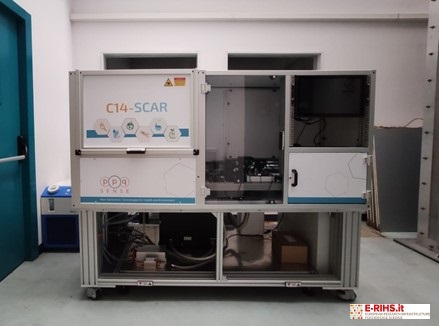
LABORATORY: CNR INO
NAME OF THE INSTRUMENT
C14-SCAR
GENERAL DESCRIPTION
The C14-SCAR analyzer is an instrument designed for trace gas detection by laser spectroscopy, exploiting the cavity ring-down (CRD) technique in saturated-absorption regime (SCAR). The device is capable of identifying radiocarbon in gaseous carbon. The precision achieved with 30 minutes of averaged measurements can approach 1% of modern carbon content (1 pMC), and its dynamic range exceeds 5 orders of magnitude. The routine preparation time for each sample is approximately 30 minutes.
The CRD technique involves directing laser radiation into a high-finesse cavity. Once a predetermined filling level is reached, the laser is turned off, and the exponentially decaying radiation exiting the cavity is detected. The decay time constant is linked to the losses in the cavity. In an empty cavity, losses are only due to mirrors; however, if an absorbing gas is present, the decay time is shorter. By comparing the decay rates between a full and empty cavity, the concentration of the absorbing gas inside the cavity can be determined.
C14-SCAR can be used to perform radiocarbon dating, a method that provides objective age estimates for carbon-based materials that originated from living organisms. The age could be estimated by measuring the amount of carbon-14 present in the sample and comparing it against an internationally used reference standard. Samples that have been radiocarbon dated since the introduction of the method include charcoal, wood, seeds, bones, shells, leather, soil, hair, pottery, pollen, wall paintings, corals, fabrics, paper or parchment, resins.
TECHNICAL DESCRIPTION
C14-SCAR system provided from Secondary Unit in Pozzuoli of CNR- INO works with two quantum cascade lasers (QCLs) emitting ~100mW @ 4.5µm. Both lasers are driven by ultra-low-noise current supplies and are safeguarded from feedback through optical isolators. The first laser, used for performing cavity ring-down (CRD), is coupled to the high-finesse cavity and is locked to the cavity for optimal resonance stability using the Pound-Drever-Hall technique. To reference the first laser to the absolute frequency of the second one, a beat note is detected between the two lasers, maintained at a constant frequency by a feedback loop controlling the cavity length. An acousto-optic modulator (AOM) ensures complete laser beam shutdown to initiate each cavity ring-down event.
The optical cavity features a vacuum system for loading and unloading the gas to be measured, multiple fittings for connecting pressure gauges and a vacuum pump, and is equipped with 8 thermistors for temperature measurement, monitored by a multisensor monitor. Designed to operate below 170 K, thanks to high thermal insulation from the external environment, it is connected to a cryocooler and boasts high-reflecting mirrors ensuring an optical finesse > 100,000.
A water-cooled low-vibration Joule-Thomson cryocooler cools the measurement cell down to 170 K. A thermoelectric chiller provides circulating cold water for cooling the cryocooler, the AOM and its RF driver.
The laser beam leaking from cavity during each CRD event is detected by a thermoelectrically-cooled mid-infrared photodiode. The photocurrent is processed by a transimpedance preamplifier and sent to a high-resolution (22 bits, 1 MS/s) digitizing oscilloscope within a PXI architecture, which includes additional modules.
The C14-SCAR instrument is provided with a GUI LabVIEW-based software for instrument control, signal acquisition and signal analysis.
Referents:
M. Giulia Delli Santi mariagiulia.dellisanti@ino.cnr.it
Pasquale Maddaloni pasquale.maddaloni@ino.cnr.it
